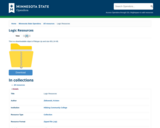
Collection of logic resources in .zip file .
- Subject:
- Arts and Humanities
- Philosophy
- Material Type:
- Data Set
- Provider:
- Minnesota State Opendora
- Author:
- Kristen Zbikowski
- Date Added:
- 12/01/2020

Collection of logic resources in .zip file .
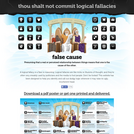
This website allows students to explore many common logical fallacies. There are some accompanying handouts to help students take notes and organize their ideas.

Microwave and RF Design: Modules focuses on the design of systems based on microwave modules. The use of modules has become increasingly important in RF and microwave engineering for rapidly realizing high performance microwave systems. When integration is ultimately to be used, building a system up using modules provides a rapid means of prototyping and testing system concepts. A wide variety of RF modules including amplifiers, local oscillators, switches, circulators, isolators, phase detectors, frequency multipliers and dividers, phase-locked loops, and direct digital synthesizers are considered. Detailed design strategies for synthesizing filters based on parallel coupled lines are presented. The reader will gain an appreciation of design by synthesis. This book is suitable as both an undergraduate and graduate textbook, as well as a career-long reference book.
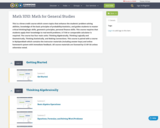
This is a three-credit course which covers topics that enhance the students’ problem solving abilities, knowledge of the basic principles of probability/statistics, and guides students to master critical thinking/logic skills, geometric principles, personal finance skills. This course requires that students apply their knowledge to real-world problems. A TI-84 or comparable calculator is required. The course has four main units: Thinking Algebraically, Thinking Logically and Geometrically, Thinking Statistically, and Making Connections. This course is paired with a course in MyOpenMath which contains the instructor materials (including answer keys) and online homework system with immediate feedback. All course materials are licensed by CC-BY-SA unless otherwise noted.
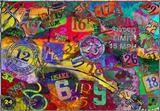
This course is an introduction to problem solving; logic, sets, and operations on sets; and properties and operations on whole numbers, integers, rational numbers, irrational numbers, and real numbers. Modelling techniques necessary for future elementary educators will also be covered in this course.
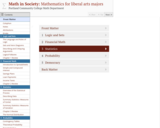
We dedicate this book to our students. May you have greater ease in paying for college and grow your proficiency and confidence in math.
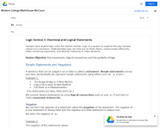
Survey course for college mathematics.
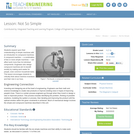
Students expand upon their understanding of simple machines with an introduction to compound machines. A compound machine a combination of two or more simple machines can affect work more than its individual components. Engineers who design compound machines aim to benefit society by lessening the amount of work that people exert for even common household tasks. This lesson encourages students to critically think about machine inventions and their role in our lives.

The Open Logic Text is an open textbook on mathematical logic aimed at a non-mathematical audience, intended for advanced logic courses as taught in many philosophy departments. It is open-source: you can download the LaTeX code. It is open: you’re free to change it whichever way you like, and share your changes. It is collaborative: a team of people is working on it, using the GitHub platform, and we welcome contributions and feedback. And it is written with configurability in mind.
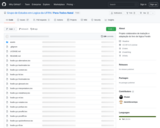
Para Todxs: Natal é um livro didático completo sobre lógica formal. Ele aborda noções fundamentais como consequência lógica e validade de argumentos, a sintaxe da lógica proposicional verofuncional (LVF) e a semântica de tabelas-verdade, a sintaxe da lógica de predicados de primeira ordem (LPO) com identidade (interpretações de primeira ordem), traduções (formalizações) do português para LVF e LPO, além de sistemas de prova em dedução natural (estilo Fitch) para LVF e LPO. Também são abordados alguns tópicos mais avançados, como a correção da LVF e uma introdução à lógica modal. O livro está disponível em PDF otimizado para visualização em tela, com links coloridos. Todos os arquivos fonte em LaTeX estão disponíveis, e podem ser também utilizados para gerar uma outra versão PDF otimizada para impressão. Posteriormente, versões especiais para visualização em tela de dispositivos eletrônicos, versões em folha preta, uma versão com fonte especial para disléxicos, além de um caderno com as soluções dos exercícios também serão produzidos. Um editor/verificador de provas para o sistema usado no livro está disponível online em andersonnakano.hyperphp.com, em versão traduzida ao português por Anderson Luis Nakano do editor original disponível em Open Logic Project.

This OER Nursing Textbook focuses on the use of critical thinking in nursing practice. The definition of critical thinking and the application of critical thinking skills in clinical practice, leadership, communication, quality improvement, and more is included. Each chapter includes images, critical thinking exercises, discussions, and activities. This textbook is found at https://thepraxisofcriticalthinkinginnursing.yolasite.com/

This course develops logical, empirically based arguments using statistical techniques and analytic methods. Elementary statistics, probability, and other types of quantitative reasoning useful for description, estimation, comparison, and explanation are covered. Emphasis is on the use and limitations of analytical techniques in planning practice.
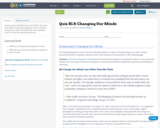
A short quiz on CCSS.ELA-Literacy.9-10.RI.8. The text is from Eliezer Yudkowsky's blog post, "How to Actually Change Your Mind". The Dale-Chall text complexity level is 7-8, and the Flesch-Kincaid is 8.6.
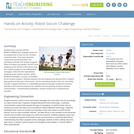
Students learn how two LEGO MINDSTORMS(TM) NXT intelligent bricks can be programmed so that one can remotely control the other. They learn about the components and functionality in the (provided) controller and receiver programs. When its buttons are pressed, the NXT brick assigned as the remote control device uses the controller program to send Bluetooth® messages. When the NXT taskbot/brick assigned as the receiver receives certain Bluetooth messages, it moves, as specified by the receiver program. Students examine how the programs and devices work in tandem, gaining skills as they play "robot soccer." As the concluding activity in this unit, this activity provides a deeper dimension of understanding programming logic compared to previous activities in this unit and introduces the relatively new and growing concept of wireless communication. A PowerPoint® presentation, pre/post quizzes and a worksheet are provided.
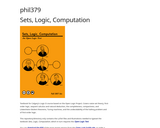
Textbook for Calgary's Logic II course based on the Open Logic Project. Covers naive set theory, first-order logic, sequent calculus and natural deduction, the completeness, compactness, and Löwenheim-Skolem theorems, Turing machines, and the undecidability of the halting problem and of first-order logic.
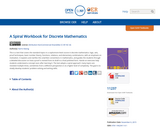
This is a text that covers the standard topics in a sophomore-level course in discrete mathematics: logic, sets, proof techniques, basic number theory, functions, relations, and elementary combinatorics, with an emphasis on motivation. It explains and clarifies the unwritten conventions in mathematics, and guides the students through a detailed discussion on how a proof is revised from its draft to a final polished form. Hands-on exercises help students understand a concept soon after learning it. The text adopts a spiral approach: many topics are revisited multiple times, sometimes from a different perspective or at a higher level of complexity. The goal is to slowly develop students’ problem-solving and writing skills.
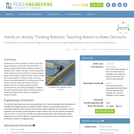
Students learn basic concepts of robotic logic and programming by working with Boe-Bot robotsâa simple programmable robotic platform designed to illustrate basic robotic concepts. Under the guidance of the instructor and a provided lab manual, student groups build simple circuits and write codes to make their robots perform a variety of tasks, including obstacle and light detection, line following and other motion routines. Eight sub-activities focus on different sensors, including physical sensors, phototransistors and infrared headlights. Students test their newly acquired skills in the final activity, in which they program their robots to navigate an obstacle course.
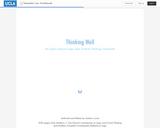
An Open Source Logic and Critical Thinking Textbook

Student teams act as engineers and learn about systems thinking and scale by reassembling the separated pages of the engaging picture book, “Zoom,” by Istvan Banyai. The book is a series of 31 wordless pictures that start very close-up and then zoom out—from a rooster’s comb to outer space. Like a movie camera, each subsequent page pulls back to reveal the context of the previous scene as something different than what you originally thought. When the 31 un-numbered pages are jumbled, it is a surprising challenge for teams to figure out how the pictures connect. The task prompts students to pause and look closer so as to adjust to new points of view and problem solve to find a logical sequence. It requires them to step back and take a broader view. Students learn that engineers work together as teams and look at things very closely so that they see different things and come up with more than one solution when problem solving. To conclude, students go outside and practice their skills by imagining and then drawing their own Zoom-like small booklet stories inspired by items found in nature. The classic duck/rabbit ambiguous drawing is provided as a kickoff visual aid.
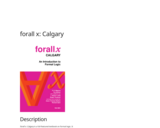
forall x: Calgary is a full-featured textbook on formal logic. It covers key notions of logic such as consequence and validity of arguments, the syntax of truth-functional propositional logic TFL and truth-table semantics, the syntax of first-order (predicate) logic FOL with identity (first-order interpretations), translating (formalizing) English in TFL and FOL, and Fitch-style natural deduction proof systems for both TFL and FOL. It also deals with some advanced topics such as modal logic, soundness, and functional completeness. Exercises with solutions are available. It is provided in PDF (for screen reading, printing, and a special version for dyslexics), HTML (with additional accessibility features), and in LaTeX source code.